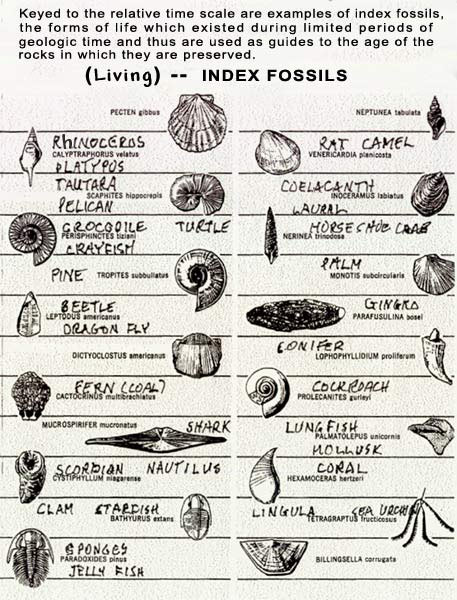

|
Evidence in science is the "name of the game." That is, if one has solid evidence backing his statements, they are likely true and he should be believed. Concerning the so-called Geological Column or geological time-scale, there is solid evidence (and lots of it) that there is no such thing as a geological column. It is a fantasy "discovered" by amateurs 200 years ago and held onto by well-meaning professional geologists ever since. Two of the amateurs were: William Smith (a civil engineer and surveyor) and James Hutton (an agriculturist). They noticed that in sedimentary layers found almost everywhere there has been uplifting. They guessed (rightly) that the deeper one goes in examining the strata, the older the layers are. What they did wrongly was to assign dates to the layers. They had absolutely no calibrated time scale to use in assigning dates. Dates were selected at random. "Card files" of strata around the world would be 60 miles deep if they could all be found in one place. But they never are. Furthermore, they are often, if not usually, out of the correct order. That is, layers that should be low down are high up, or even on top, and vice versa. As we mention above, amateur geologists assumed that fossils found in rocks would be older low in the strata, and younger higher up. Being evolutionists, they postulated that new species were continually being formed by their predecessors. Thus, layers found just above basal rocks were the earliest life forms. As these died out, they believed new life forms were developing and being fossilized higher in the strata. Of course, most people know that fossils, by their very nature, are formed quickly or they would rot before being fossilized. Tender fern leaves, found fossilized in coal, for instance, would only last a few hours once they were severed from their host plant. So, we could well surmise, even postulate, that all coal was formed by the sudden burial of huge forests of ferns and other plants.
"Living Fossils" Sound Death Knell for "Geological Column"Continuing, we want now to examine evidence which doesn't just cripple the concept of a geological column -- but rather DESTROYS it! What is this which can destroy a "fact" of science so necessary to evolution? It is "Living Fossils." They eliminate "index fossils" which are used to date geological layers. How can we possibly make such a dogmatic statement? Because these "index fossils" have become "living fossils" in such large numbers that they can no longer be used to date any of the layers. What are "living fossils?" They are fossils which are believed by evolutionists to have been formed millions of years ago. Since each of them supposedly evolved into new and different life forms it is hoped that they will never be found in later strata. Evolutionists depend on these index fossils. So much so that they have developed a series of them from the earliest to the latest. (See the graphic on this.) Why do we think that "living fossils" eliminate the geological column? The answer is quite simple. But the impact of it somehow seems to have escaped evolutionists. To grasp the implications of this, here is an example of what we mean. A well-known "living fossil" is a fish called coelacanth." It was found fossilized early on and the estimate, or guess, of its age was 300 million years. Later estimates (guesses) reduced the age of this fossil to 150 million years, and still later it was reduced to 75 million years. (Those are enormous differences, of course, and should cause caution on the part of researchers.) This writer does not believe in such enormously high dates. However, let's grant that they are acceptable and look at the reasoning behind such vast ages. If the coelacanth. is used as an index fossil it must have died out entirely 300 million years ago (or 150 or 75 million, whichever is felt to be the most likely). Thus it should be impossible to find any living on the earth at the present time. But, LIVING COELACANTH. HAVE BEEN FOUND IN MADAGASCAR and they are EXACTLY THE SAME as the fossils! They never evolved, but have continued the same ever since they were created. They cannot be "index fossils" anymore because they would have existed (in the evolutionary time frame) 300 million years ago. They would also have been found 75 million years ago, and they were still around 10 million years ago, and even 1 million, or 100,000 years ago, and so on, down to this very hour! They cannot be used to date any stratum in the column -- none at all -- for they are still being found alive and unchanged. However, the coelacanth. is not alone. There are large numbers of "living fossils," all of which are evidence against the Geological Column, causing its collapse -- except in the minds of those who don't want evidence, but believe it by faith! The facts -- the evidence -- is stacked against geological dating through index fossils. Evolutionary believers no longer have "young" and "old" rocks with certainty, because "living fossils" have been present for long intervals even though their fossils have not been preserved between those intervals. In the diagram with this article are found some of the better-known living fossils. Less well-known fossils are just that because their Latin names are used which makes them unfamiliar to the layman, and even somewhat exotic. On the other hand, we have used familiar names for other index fossils found in the same strata. 
Radioactive Isotopes Do Not Help in this SituationThere are several of these, but they cannot help in dating because they cannot be calibrated against known dates. For instance, to take a person's body temperature one needs a calibrated thermometer. Without it all is guesswork. The patient might seem to have a fever, but we can only guess at their temperature without a thermometer calibrated using a standard instrument. Nor can we tell the age of a rock using isotopic dating unless the instruments used to measure the quantifies of isotopes have been calibrated against known ages. But, sorry to say, there are no historical records beyond 5,000 years ago. Historical records are the proper basis for ALL dating, both scientific and historical even though that fact is ignored by many evolutionists. We expect geologists to object that there are several methods used to date rocks and they all show similar ages. Thus they can be trusted to be reasonably correct. But, they cannot!* And here are reasons why not:
Please note that what we are measuring using radio isotopes is NOT time. Measurements are made of the quantity of selected elements in the rock sample. Presumably, the decay rates of these radioactive elements can be measured in time. However, their weaknesses are listed above. Extinction Is the Opposite of Living Fossils
The point is: GENES plus MUTATIONS = EXTINCTION, NOT EVOLUTION! *Except for the C14 method which can be calibrated fairly accurately back to 5,000 years before the present [BP]. But earlier than that, historical records are not available, making dates highly suspect, according to Willard Libby, the discoverer of the C14 dating method. |
||||||||||||||||||||||||||||||||||